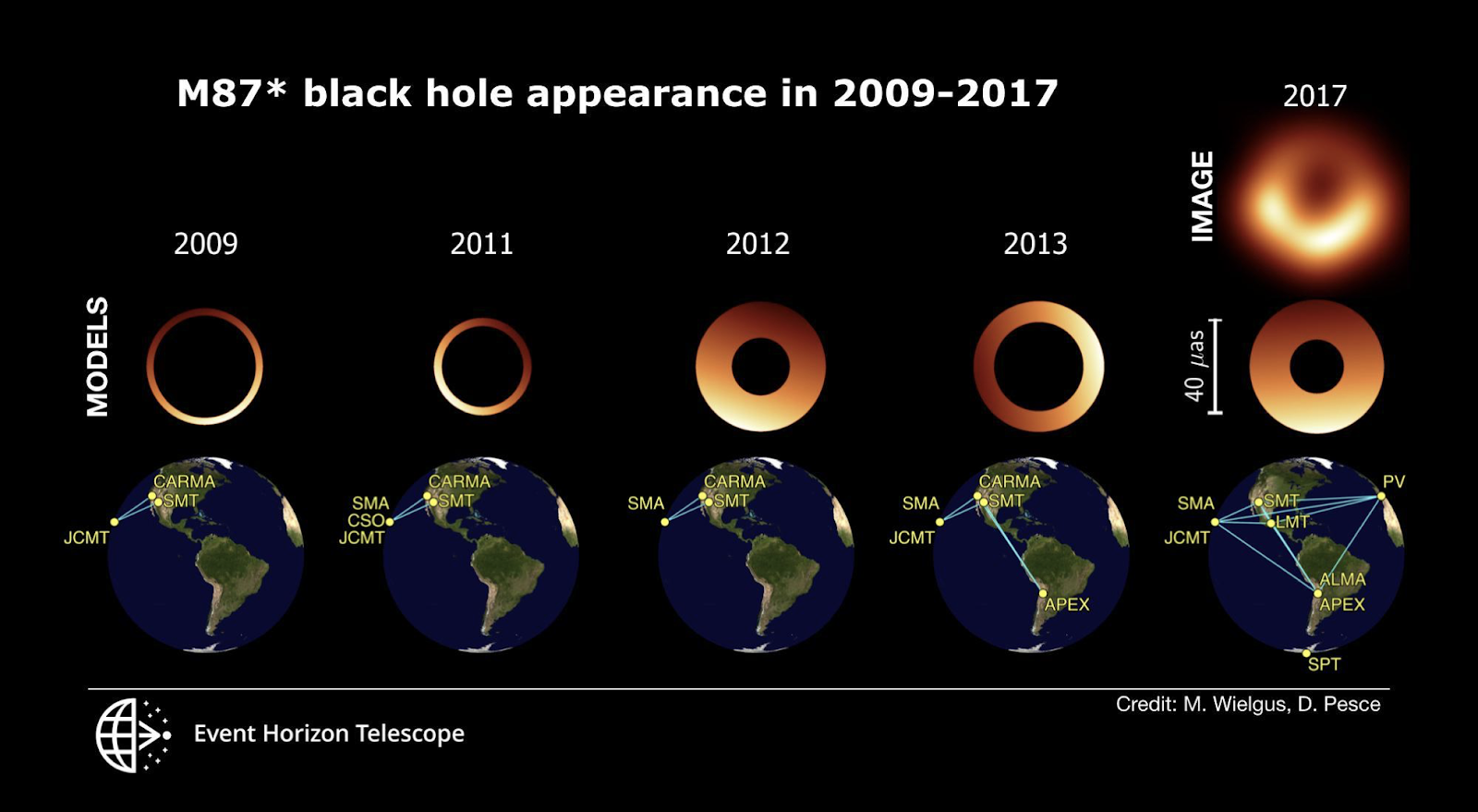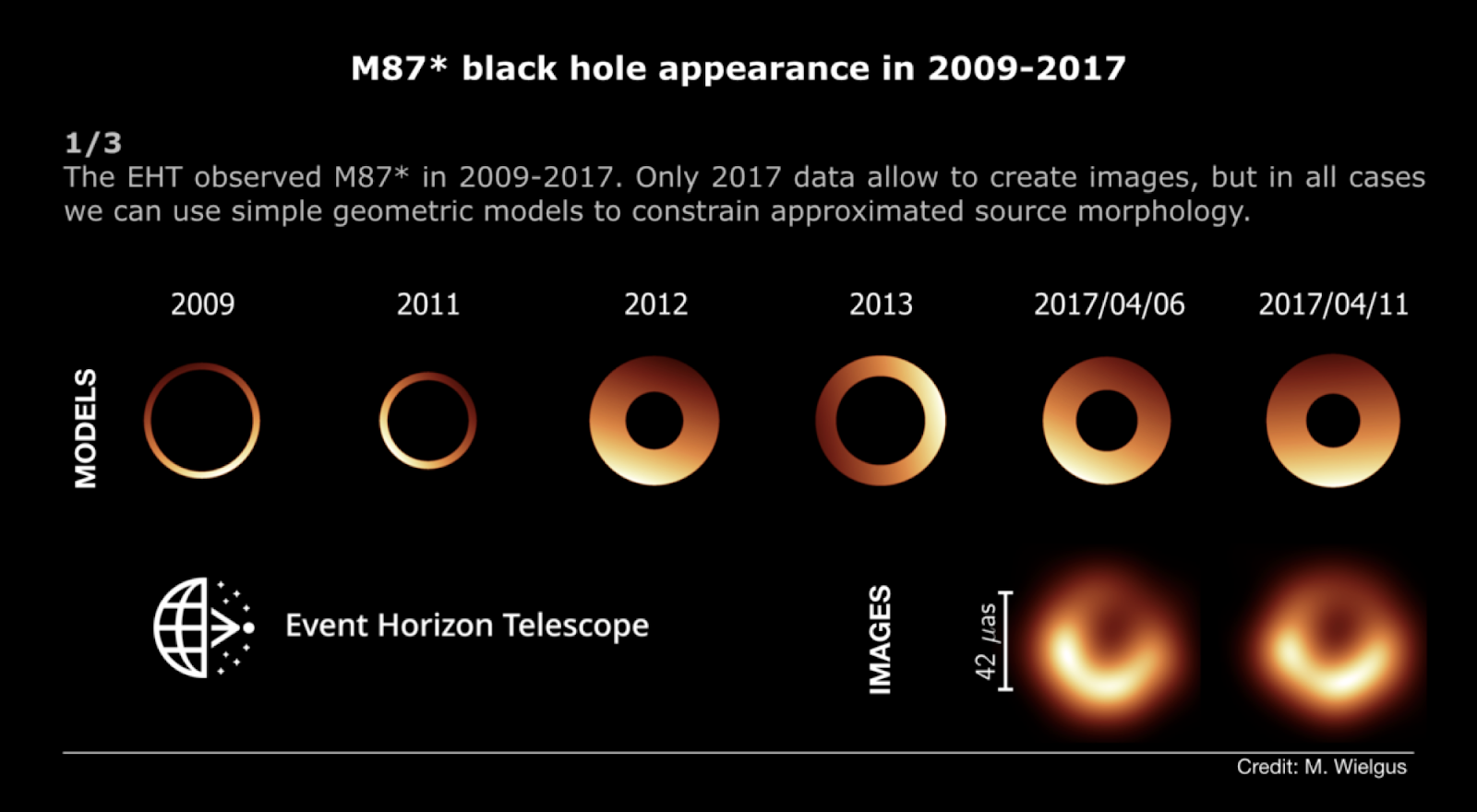Wobbling Shadow of the M87* Black Hole
Analysis of the Event Horizon Telescope observations from 2009-2017 reveals turbulent evolution of the M87* black hole image
Researchers of the IAA participate in this work which opens a completely new window towards the study of black holes
This comprehensive analysis has revealed the behavior of the black hole image over several years. The results show temporal variations in the orientation of M87*'s characteristic crescent-shaped shadow, compatible with an apparent "wobble". The results are published today in The Astrophysical Journal.

Snapshots of the M87* black hole obtained through imaging / geometric modeling, and the EHT array of telescopes in 2009-2017. The diameter of all rings is similar, but the location of the bright side varies. Credit: M. Wielgus, D. Pesce & the EHT Collaboration
Taking data for more than a decade
The EHT is a global array of telescopes, performing synchronized observations using the technique of Very Long Baseline Interferometry (VLBI). Together they form a virtual Earth-sized radio dish, providing an uniquely high image resolution. “With the incredible angular resolution of the EHT we could observe a billiard game being played on the Moon and not lose track of the score!” said Maciek Wielgus, an astronomer at Center for Astrophysics | Harvard & Smithsonian, Black Hole Initiative Fellow, and lead author of the paper.
“Last year we saw an image of the shadow of a black hole, consisting of a bright crescent formed by hot plasma swirling around M87*, and a dark central part, where we expect the event horizon to be,” said Wielgus. “But those results were based only on observations performed throughout a one-week window in April 2017, which is far too short to see a lot of changes. Based on last year’s results we asked the following questions: is this crescent-like morphology consistent with the archival data? Would the archival data indicate a similar size and orientation of the crescent?”
Extending the analysis to the M87* observations obtained between 2009 and 2017 - with an EHT prototype, with a smaller number of telescopes - the first thing scientists have shown is that the diameter of the black hole's shadow has remained constant throughout this period, and is also consistent with Einstein's theory of general relativity prediction for a 6.5 billion solar mass black hole.
But while the crescent diameter remained consistent, the EHT team found that the data were hiding a surprise: the ring is wobbling, and that means big news for scientists.

An animation showing the consistency of the measured ring diameter and the uncertainties of the orientation measurement. Credit: M. Wielgus & the EHT Collaboration
For the first time they can get a glimpse of the dynamical structure of the accretion flow so close to the black hole’s event horizon, in the extreme gravity conditions. The gas falling onto a black hole heats up to billions of degrees, ionizes and becomes turbulent in the presence of magnetic fields. Because the flow of matter is turbulent, the crescent appears to wobble with time.
"Once again the EHT opens a completely new window in the study of black holes, allowing us this time to get a first look at how they 'gobble up' material around them and turn them into the most energetic objects known in the Universe," said Rocco Lico, member of the EHT team at the IAA-CSIC participating in the study, along with the researchers José Luis Gómez, Guang-Yao Zhao, and Antxon Alberdi.
An animation representing one year of M87* image evolution according to numerical simulations. Credit: G. Wong, Ch. Gammie, M. Wielgus & the EHT Collaboration
"These early observations of the EHT provide us with a treasure that, even with the extraordinary resolution of its current configuration, cannot be matched," says Shep Doeleman, Founding Director of the EHT. "When we first measured the size of M87* in 2009, we could not imagine that it would help us unravel the dynamics of black holes. If you want to see a black hole evolve over a decade, there's no better way than having a decade of data."
The EHT collaboration scientists are planning to monitor M87* with an expanded EHT array. The 2018 observations were performed with an additional telescope located in Greenland and in 2021 observations with two more sites are planned. This will provide an extraordinary imaging quality and much richer data sets to study the turbulent dynamics.
Jose Luís Gómez (IAA-CSIC) - jlgomez@iaa.es
Instituto de Astrofísica de Andalucía (IAA-CSIC)
Unidad de Divulgación y Comunicación
Silbia López de Lacalle - sll[arroba]iaa.es - 958230532
http://www.iaa.es
http://www-divulgacion.iaa.es

